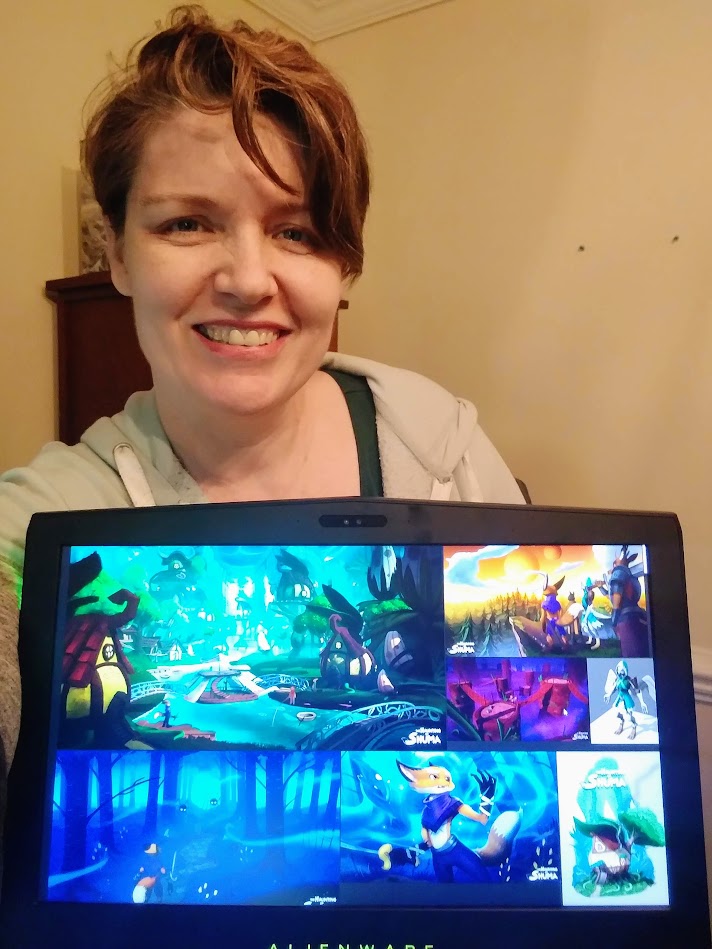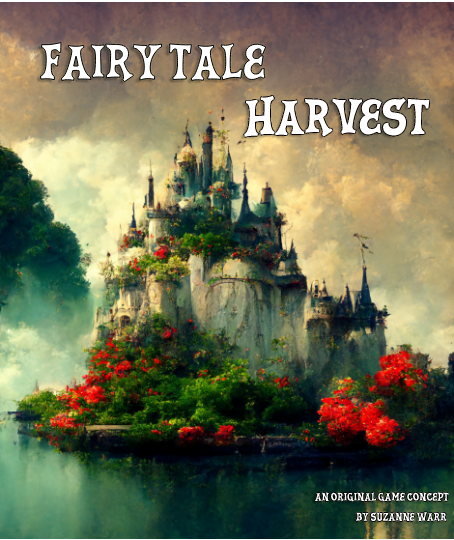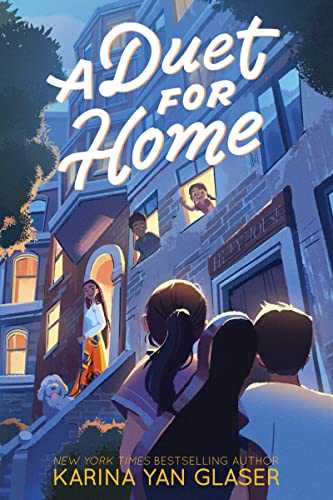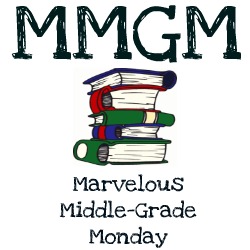I can’t believe it’s been since April of last year since I posted! I’ve thought through posts in my head so many times it felt like I was still here…somewhere. It’s good to connect again now!
I want to share what I’m working on for this coming year and ask for your help with one goal there, but first let me give you a quick rundown of what I’ve been up to since I reported on ECGC last April. And then at the end I’ll squeeze in a spotlight on my latest book love!
- In April at the East Coast Game Conference I met the DreamSail CEO and the art director, and interviewed for the position of narrative designer. After sharing writing samples and doing a writing test, in early May I was hired to write the vertical slice for DreamSail’s new game they were working on. It was a gorgeous and rich new jRPG called The Haunting of Emoren that they hoped to crowdfund. I got to write the vertical slice script, which included writing side quests and fleshing out the lore plus of course the actual dialogue and script for the opening cutscene and extensive playable demo. In the end, the studio (which had brought in some new management), experienced issues and closed its doors in the fall before the kickstarter would have released, and the game was scuttled. However, I learned so much from working inside a game studio and rubbing shoulders with other game creators as we took ideas from pre-concept all the way through to created assets and in-game reality. For one of the quests I created a language and a basic runic alphabet, and it was such fun to see those runes incorporated into a stain glass window by the art team! I made good friends, gained insights into the do and don’ts of the industry, and learned where my own weaknesses were as a narrative designer so I could address them.
Here’s a pic with a few images from the game from when I announced on social media that I’d joined the team. It really was a marvelous experience!
- In September I worked as game writer on an arcade game called Sleepmare that will release on Steam sometime this spring. The bones of the story were already in place but the characters needed work and the dialogue needed more personality and pizazz. I gave it that and also helped the developer tweak their (static) cut scenes.
- In October I worked with DreamSail’s former CEO (and one of the team’s lead artists), providing him with developmental edits on a manga he’s creating using a rich new fantasy world. I’m continuing to consult there and am excited to see it progress!
- Also in the fall I decided it was time I learn how to write a GDD, or Game Design Document. DreamSail already had one by the time I was brought on board but I realized while working with it that my writing experience to date had not prepared me to write one. So, I signed up for The Art of Writing for Games. It’s offered through classpert and taught by script and game writing greats JZP and Flint Dille, who between them have worked on everything from Jurassic World to Transformers, and most recently were integral in developing PokemonGo with Niantic. JZP and Flint were warm, encouraging, and generous in sharing their insights and industry experience and giving each of us in the cohort individual and hands-on feedback.
The class ran from October through December and was a truly transformative experience. I learned so much as we dug deep into how to build a high concept game design document from the ground up, working first through world building templates, various character building sheets, studying how to best establish tone, and creating a strong game writing sample. We also created within our GDD a ‘one sheet’ pitch document, and as part of that we studied positioning our IP within the industry and meeting audience needs. Finally, we were coached on how to make a successful pitch and on the last day of class we practice pitched to industry professionals. I was fortunate enough to pitch to John Nee, former head of Marvel’s comics publishing and industry legend, and got invaluable feedback from him on my game concept and the franchise potential within this world concept. He was gracious enough to continue the conversation beyond pitch day and has been truly generous and supportive in our communication since.
I really really want to share a link to my GDD, which turned out pretty great if I do say so myself (and which classpert asked if they could use as a sample on their website…though I regretfully had say no to that) but I still plan to pitch this game in future so I won’t link that now. However, here’s a taste, of the art I pulled together using Midjourney’s AI. I won’t be using AI art for anything beyond concept-generating, but it’s perfect for stuff like this and I was pleased with how it came out.
- And finally, throughout the fall as I worked on my game document fleshing out the world I realized I want to return to my roots of this world and write books that companion my games. I’m calling it the world of Unwanted Fairy Tales, and in a way this is a full circle journey because I started playing in this world with a mg book called Once Upon a Witness, that I pitched when I signed my agent, Peter Rubie, some five years ago. Unfortunately, at the time we found selling a book of this type an uphill battle. Publishers liked it, but already had a ‘princess book’ and couldn’t find room for it.
However, from the beginning the story of Prince Robin, who is Queen Snow White’s son from her hushed up first marriage, has been banging in my head and asking for release. Prince Robin is half goblin (though high goblin and of royal blood), which is taboo to the point of being illegal according to the Organization of Fairy Godmothers. He suffers from debilitating anxiety which is made worse by his inability to accept himself or come to terms with his mother’s expectations as she strives to make up for her ‘mistake’ which resulted in him being born. So, even though publishers are still considering When the Dragon Comes, this winter I started quietly working on Prince Robin’s story, and should finish it by the end of January. Possibly sooner, since it’s a quick read that will clock in at 40k, but I’m taking my time and getting each word just right.
And that brings me to my question, or request for your help. I am finally (finally!) fully vaccinated and plan to break out of my shell and take Prince Robin’s story up to SCBWI’s national winter conference in New York in February. I’ll hopefully get to meet my agent face-to-face for the first time while up there, but I don’t think he’s planning to be at the conference and he has encouraged me to connect with editors in person where possible, as that’s a great way to open doors. So, what are your suggestions for how I can make the most of my opportunity? What do you advise I do to help connections happen? Do you know of anyone who’ll be attending that I could look out for? I want to give Prince Robin’s story the best possible chance, not least because there’s all kinds of game tie-ins buzzing in my brain in addition to Fairy Tale Harvest, cause it’s easy to think of ways to make games from a fairy tale prince who reverts to frog form whenever he’s anxious!
And finally, will any of you be there? I’d love to see a familiar face! I’ll be masking, but I’ve learned to work around that and I’m sure we’ll have a great time. 😀
Last but not least, this mammoth post won’t be complete without my giving A Duet For Home a shoutout!
I became a fan of Karina Yan Glaser within a page or two of reading the first of her Vanderbeekers books. I love the way her books make me believe in a world that’s better than the one I’ve always known, and the sweet, wholesome way the Vanderbeeker kids always believe things can work out if only they put their heads together and come up with a solid, creative plan. And it does work out! Their world is what you’d get if rose-tinted glasses were the real thing.
A Duet For Home somehow manages to have that same magic, even though it deals with the lives of kids who’ve had their world turned upside down and their rose-tinted glasses smashed on the ground. It starts when June, her mom, and her little sister Maybelle move into a homeless shelter for families, called Huey House. They were evicted from their apartment after their dad died and their mom stopped talking or working. In alternating chapters we get Tyrell’s pov. He’s been at Huey House for over three years, and the shelter is such an improvement on his life before that the thought of leaving fills him with sick dread. The kids deal with the kind of struggles you’d expect plus some you wouldn’t, and have to rally their schools and community when it looks like a well-meaning city policy adjustment will mean they could lose even the safety Huey House has come to be.
One of the things I love most about this story is the way June’s viola becomes a central piece and the story begins to revolve around it. As the music she makes ripples outward in her life, she is able to bring empathy and healing in unexpected ways. If anything, the reader is able to see that through this traumatic experience and upheaval, June and her music have been enabled to reach deeper into people’s lives and make a bigger difference than they ever could have had things gone smoother.
I also loved the frank admittance that sometimes the biggest hurdle a kid faces is the failure of the adults in their life to manage themselves. This is something I connect with deeply but often gets glossed over. So many mg stories have dead parents, or parents who’re excused for some reason. It’s always refreshing when a story acknowledges the great societal deficit many kids face because their parents have fallen into a hole–pulling their kids in with them–and can’t seem to find their way out. In the case of June’s mother, that hole was brought on by shattering grief compounded by her being a first generation immigrant without adequate support to see her safely across this chasm. It’s so easy to see how she could fall down in the face of her challenges, but heartbreaking to know the price June and Maybelle could/will pay. It’s hard to see adults fall apart. Hard to see them fail to handle grief in ways that still shelter their little ones. But it’s also the reality so many kids have faced and will face. And yet, there can still be hope, there can still be safety, and their can still be growth from those hard places.
This is something A Duet For Home does a beautiful, masterful job of handling. I honestly don’t know how one could expect a middle grade book to tackle the subject of child homelessness and parental failure and loss while retaining that intrinsically hopeful perspective that is the hallmark of middle grade…and yet this book does. It has become an instant favorite, so I’m recommending it now to you! Yes, it will quite likely make you cry. But it won’t be dark or depressing and you’ll be smiling in the end.
That’s it from me. I hope you are having a hope-filled and joyful beginning to the new year! Please tell me what you’ve been up to, give me your recs re: the conference, and make sure you pop over to Greg Pattridge’s blog for the full list of MMGM book recommendations, giveaways, and spotlights. And happy 2023 to you and yours!




Natalie Aguirre
Suzanne Warr
Patricia Tilton
Z
Valinora Troy
Z
Greg Pattridge
Z
Rosi Hollinbeck
Suzanne Warr